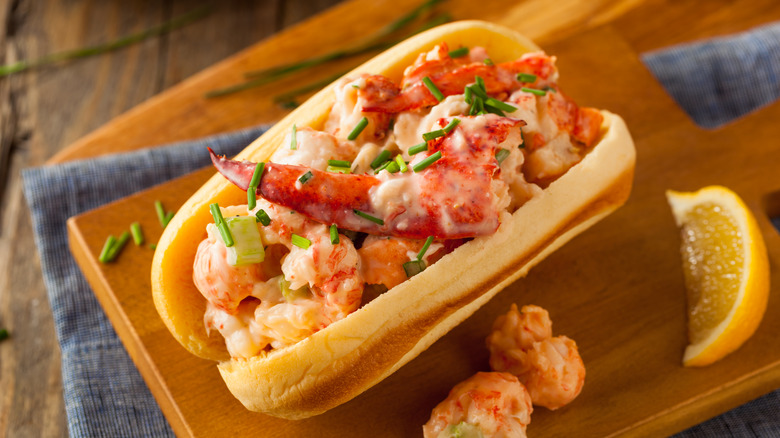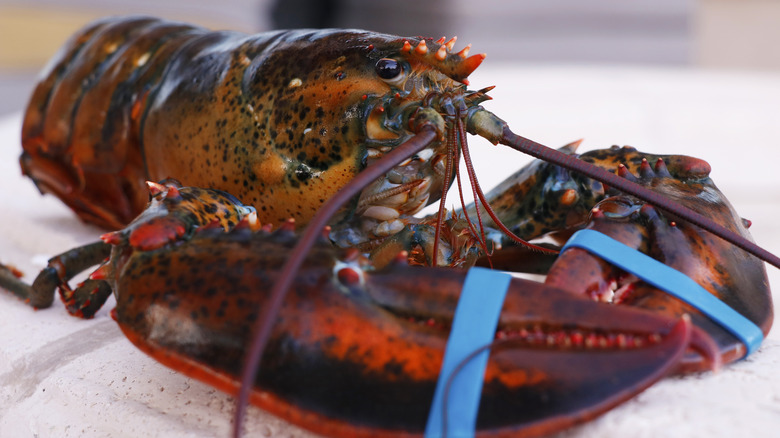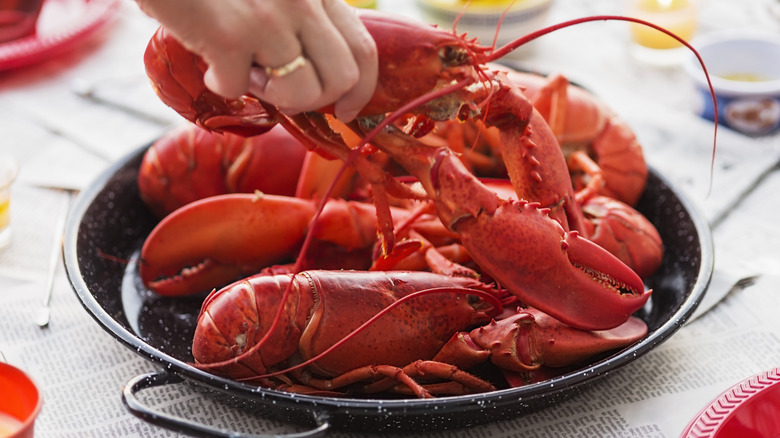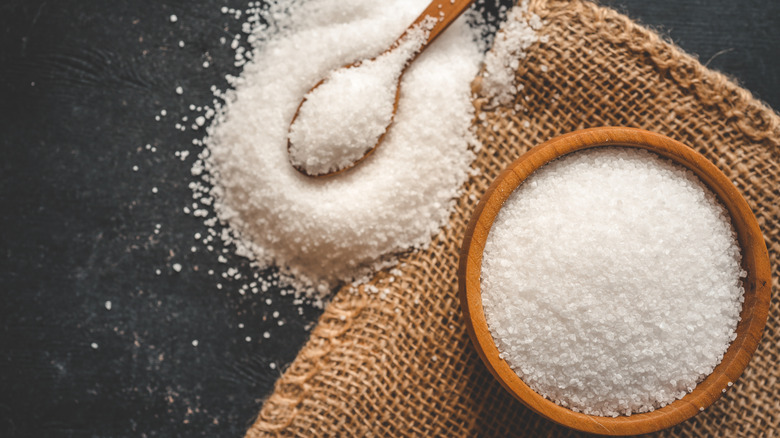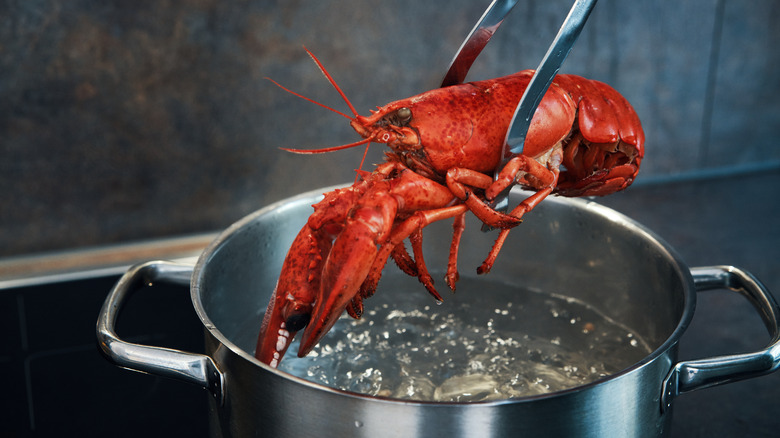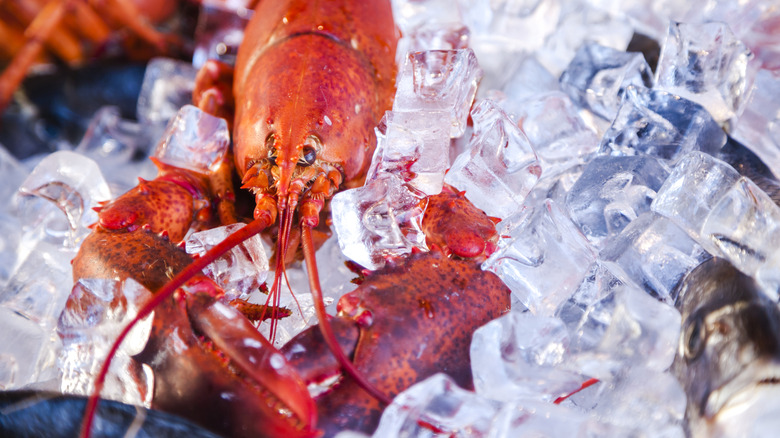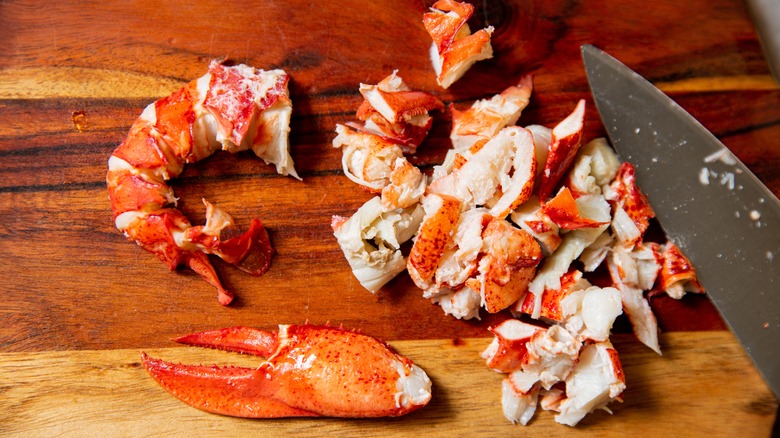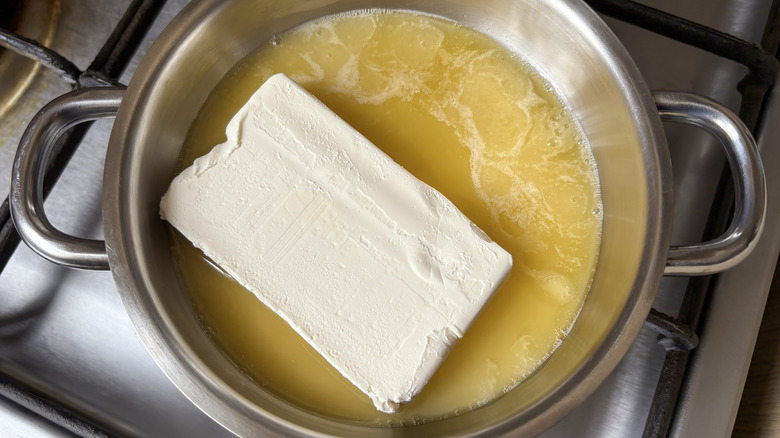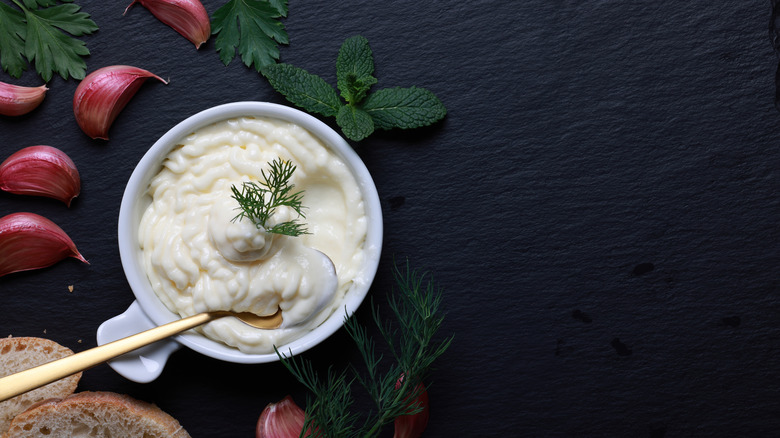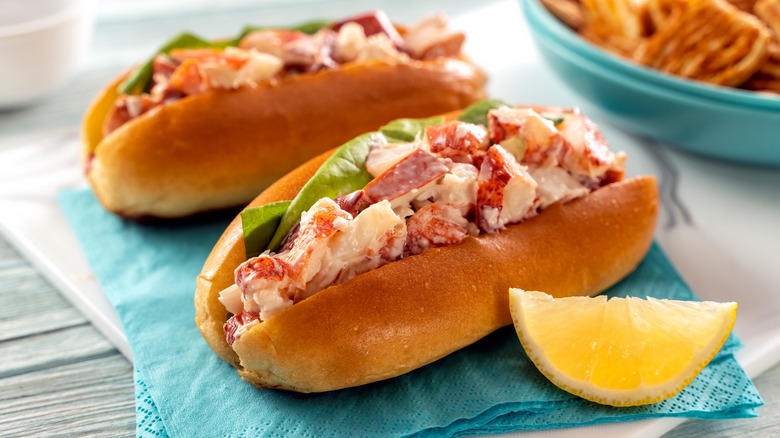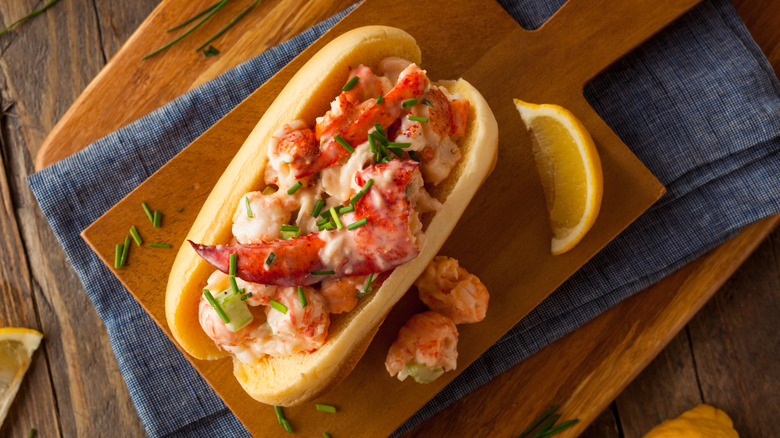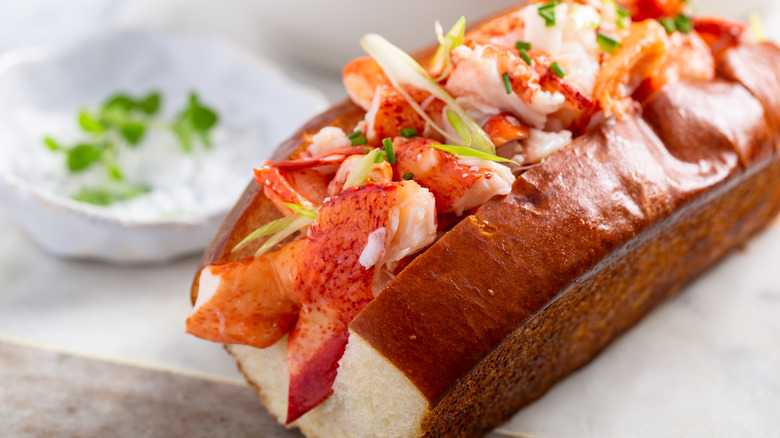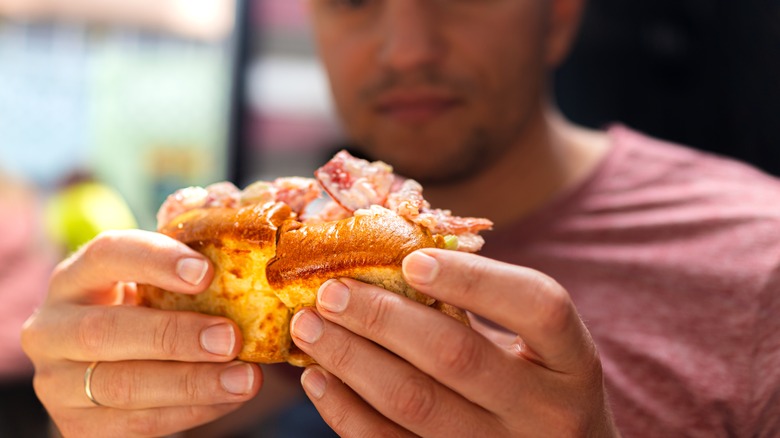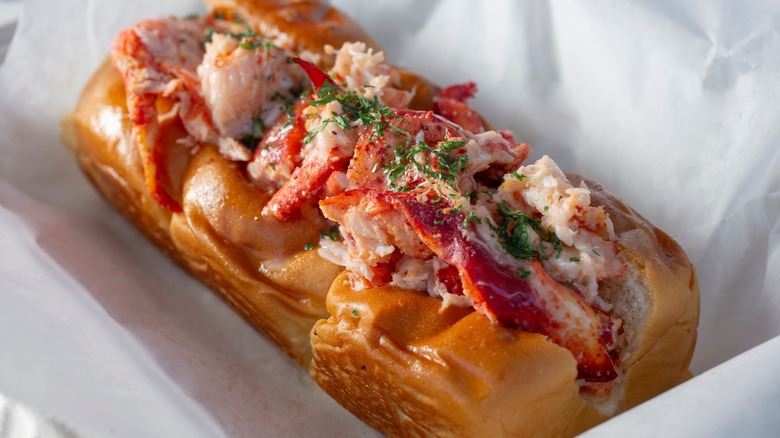13 Tips For Making A Mouth-Watering Lobster Roll
Having grown up in Nova Scotia, lobster rolls are in my DNA. I've eaten them at beachside shacks, sophisticated restaurants, backyard picnics, and festivals. I even tried the McLobster from McDonald's once, quickly vowing never to make that mistake again. Over the years, I've learned that a good lobster roll doesn't need much — just quality lobster, the right kind of bun, and a light hand with the extras. That being said, nailing a mouthwatering lobster roll at home takes some attention to details.
To figure out exactly what those details are, I spoke with several chefs and restaurateurs who know lobster rolls inside and out. They shared some great tips for constructing the perfect lobster roll including how to cook the lobster for the best flavor and texture, choosing the correct bun, and little touches that can elevate the dish to something worthy of a top East Coast lobster roll spot. Turns out, there's a bit more to it than just tossing lobster in a bun. Here are their best tips for making a lobster roll that actually lives up to the hype.
1. Fresh lobster is essential
While every chef has slightly different methods for preparing the perfect lobster roll, one thing that everyone we spoke to agreed on was that fresh lobster is an absolute must. Steve Kingston, owner of The Clam Shack in Kennebunk, Maine, and advisor to the Maine Lobster Marketing Collaborative, recommended picking out and cooking the lobster yourself or going to a fishmonger that picks fresh meat on-site. He said, "You'll not only ensure quality but also get more meat for your money, including tasty bits from the legs and body that typically aren't sold in pre-picked packs."
In addition, when you pick out your own lobster, you can choose the best looking crustaceans in sizes that work best for you. As many lobster lovers know, the biggest lobster isn't always the best choice because the meat can be tougher and harder to cook evenly. In general, a 1.5-pound to 2-pound lobster should be easy enough to cook and yield enough meat to make one lobster roll. Look for lobsters that are active and bright-eyed. Kingston also suggested, "If you can find them, use soft-shell lobsters — they're more tender, sweeter, and cook beautifully."
2. Consider cooking your lobster a day in advance
If you're planning to impress family and friends with homemade lobster rolls, Jim Foster, owner of Pelican Seafood Market & Grill in Ottawa, Ontario, recommends cooking your lobster the day before your feast. This can free up time and keep the day-of prep more relaxed and manageable. Plus, chilled lobster meat is easier to shell, chop, and portion without falling apart. Foster advised, "Let them rest in the fridge overnight, shell side down to absorb the most lobster flavor." You'll also want to keep the lobster in an air-tight container to keep it as fresh-tasting as possible.
When it's time to assemble your lobster rolls, executive chef John Shaw of The Boathouse Restaurant in Kennebunkport, Maine, told us mise en place is key. This is a French culinary term that translates to "everything in its place," and it refers to setting up everything you need ahead of time. Shaw explained, "Meat is picked, mayo is ready, lemon is juiced and zested." This step allows you to work quickly and efficiently so that nothing sits around for too long and you can load up those lobster rolls while the buns are still warm and toasty. Plus, it can help make clean-up easier.
3. Season your cooking water
Several of the chefs we spoke to emphasized the importance of seasoning your cooking water to get the best tasting lobster meat. "In a perfect world, use salt water from the ocean," said chef Nicole and co-owner Peter of Osprey's Nest Public House in Petite Rivière, Nova Scotia. For those who don't have access to fresh, clean ocean water, just add a generous pour of salt into your cooking water. About a ¼ cup of salt per gallon of water should do the trick.
Some chefs take things a step further by adding extra seasoning to their cooking water. Guillaume Thivet, executive chef of Grand Brasserie in New York City told us, "I usually use a court bouillon to give extra flavor, so I will go with water, celery, onion cut in half, carrot, bay leaves, white wine, and lemon." If you decide you want to add some extra flavor, just remember not to go overboard. The goal is to enhance the lobster, not mask it. A lightly aromatic base can add subtle depth, but at the end of the day, the lobster should still taste like lobster.
4. Cook the lobster gently
Cooking lobster may seem simple, but doing it well means paying close attention to heat and timing. If you throw your lobsters into water that's at a full rolling boil, you risk overcooking them and ending up with tough, rubbery meat. Michael Handal, chef at the Institute of Culinary Education, told us, "When we speak of 'boiling' a lobster, don't think of the water boiling as with pasta. Instead, have the lobster cooking in water that is about 195 to 200 degrees Fahrenheit." Steaming is another option and the sous vide method is also great for lobster rolls.
How long you cook your lobster really depends on the size. Smaller lobsters may only need about 10 minutes, while larger ones might take about 20 minutes to cook properly. Handal also brought up the point that larger lobsters can cook at different rates with the knuckles and tails cooking before the thick claws. If you're going with heftier lobsters, you may want to cook the lobster in pieces. In terms of doneness, Steve Kingston told us you want to cook them, "until they turn a vivid red-orange and their tail snaps back firmly when you try to straighten it." To avoid overcooking or undercooking your lobster, aim for an internal temperature of about 135 to 140 degrees Fahrenheit.
5. Be sure to chill the lobster meat
If you want tender, perfectly cooked meat, you need to stop the cooking process as soon as the lobster comes out of the pot. "Overcooked lobster gets rubbery and loses its sweetness," said Maricel Gentile, chef and founder of Maricel's Kitchen in East Brunswick, New Jersey. Like many chefs, she recommends immediately chilling the lobster in an ice bath consisting of ice cubes and water. This process is called "shocking," and it prevents residual heat from overcooking the meat. It also makes the lobster easier to shell.
This is a great time to bring up the great Maine vs. Connecticut lobster roll debate. Basically, Maine-style rolls feature cold lobster meat dressed with mayo, while Connecticut rolls feature warm lobster meat with melted butter. Obviously, chilling your lobster meat is essential for a Maine-style lobster roll so that you can get the meat fully cold and firm. With Connecticut-style rolls, you still need to cool the lobster to stop it from overcooking and make it safer to handle. Some people run it under cool water so that it retains some warmth, while others shock it and then gently reheat it in butter (more about that later).
6. It's all about the TCK (tail, claw, and knuckle)
No matter what style of lobster roll you're making, the most important part is the meat, which brings up the question of which parts of the lobster belong in the roll. Not all the chefs we spoke to agree on this point. When we asked Kevin Conway of Rowayton Seafood in Norwalk, Connecticut, how he constructs his lobster rolls, he told us, "All parts of the lobster are used — tail, claw, and knuckle." Many chefs believe that the TCK approach gives the best flavor and texture and adds heartiness to the roll.
Then there are chefs who opt to leave the tail meat out altogether. Guillaume Thivet said, "I personally prefer the sweeter, more succulent claw and knuckle meat." People in this camp often point out that the tail meat is firmer than knuckle and claw meat, so by leaving it out, you get a more consistent texture that's softer and more delicate. Of course, if you like a bit of variety and don't mind a firmer chew, adding some tail meat is fine. Just be sure to chop it into smaller pieces so it doesn't overpower the more tender parts.
7. Butter poaching the lobster can kick the flavor up a notch
At Benny's on the Beach in Lake Worth, Florida, warm lobster rolls are big sellers, even on days when the South Florida temperature soars. When we asked co-owner Dylan Lipton what the secret is, he told us, "Heating the meat in a pan with garlic butter is always the best way to bring out the flavor of the meat." Butter poaching lobster helps the meat stay juicy, tender, and rich without drowning out its natural sweetness. Lipton's method of adding garlic adds extra flavor and depth. Kevin Conway also poaches his lobster in butter and adds a splash of lemon and a dash of Old Bay Seasoning.
To butter poach your lobster right, keep the heat low. The butter should be warmed just enough so that the lobster heats through without toughening. Use unsalted butter so you can control the salt, especially if you're adding other seasonings. If you're using garlic or aromatics, cook them in the butter first to let the flavors bloom before adding the lobster. Cut the meat into chunks so that it warms evenly, add it to the butter and add stir it occasionally, warming it just long enough to soak up a little flavor without turning rubbery.
8. Quality ingredients make a huge difference
When it comes to lobster rolls, less is more, but that "less" has to be top quality. As Steve Kingston put it, "The best lobster roll doesn't need fancy ingredients. Just use high-quality lobster meat, good mayo, melted butter, and soft white bread. That's it." As mentioned, you want fresh lobster meat from a reputable source. Dylan Lipton recommends lobster sourced from Maine. I would also argue that Nova Scotia lobster is pretty darn delicious, although it might be harder to find outside of Canada.
If you really want to let that quality lobster meat shine, the other components of the roll should be just as top-notch. Instead of opting for generic mayo, a few chefs recommended going with a Japanese mayonnaise like Kewpie. John Shaw said, "It offers a more tangy and sweet flavor versus traditional mayonnaise." Several chefs prefer to dress their lobster rolls with a house-made aioli. And most agree that a really great fresh roll is a thousand times better than a store-bought bun that's been sitting in a bag for who knows how long.
9. Temperature matters in the mayo vs. butter debate
There are some pretty strong opinions about the best way to serve a lobster roll, but it's the temperature that often dictates whether butter or mayo wins out. As Dylan Lipton said, "Both warm and cold rolls can be really wonderful, but they must be prepared differently." If you're going for a cold, Maine-style roll, mayo or aioli work best because you get creaminess and a slight tang that can complement the sweetness of the meat without overpowering it. On the other hand, a warm Connecticut-style lobster roll does better with melted butter because it seeps into the meat and enhances the richness of the meat.
If you're wondering whether you can combine both butter and mayo to make an ultra-indulgent lobster roll, Michael Handal warned that the results might not be so appetizing. He explained, "The mayo will break down when warm, leaving you with a broken-looking dressing floating in the butter." That's not only visually unappealing, but it can also make for a pretty slimy texture. Most chefs would agree that it's best to keep warm with warm and cold with cold. That being said, a buttery, toasted bun is always fair game.
10. Go easy on the seasoning
Whereas your everyday tuna sandwich might need an upgrade from add-ins like crunchy vegetables, zingy jalapeños, or umami-rich fish sauce, lobster doesn't need much. In fact, the more you add, the more you risk losing the flavor you're paying for. All you need is either butter or mayo and perhaps a few basic seasonings to subtly enhance the flavor of the meat. As the team at Osprey's Nest Public House advised, "Let the lobster be the STAR of the show and minimize fillers."
If you want to infuse some extra flavor into your lobster roll, many chefs recommend lemon juice or lemon zest. The citrusy flavor can brighten up the roll without detracting from the lobster meat. Maricel Gentile said, "If I have calamansi juice on hand, I'll splash just a few drops for a gentle Filipino wink that feels like sunshine." Other popular accoutrements include a sprinkling of chives, finely chopped celery, parsley, or tarragon. For an unexpected condiment, Dylan Lipton recommends tomato relish in a warm lobster roll, a pairing that he told us works surprisingly well. No matter what seasoning you use, the key is to go ultra light.
11. Split-top buns and brioche rolls work best
Nearly every chef that we spoke to told us that best bread for a lobster roll go is a split-top bun, also called a New England-style bun. While regular hot dog buns are cut on the side, split-tops are cut at the top. That allows you to fill and eat the roll with less chance of the meat spilling out. As Maricel Gentile said, "It cradles the lobster just right, and that warm, toasty exterior with the cool lobster salad is pure summer happiness."
Some chefs also insist on a split-top brioche bun, which adds a slight sweetness and richness that can complement the lobster meat. Steven Kingston takes that one step further and uses a round brioche roll at The Clam Shack. He explained that during the '80s, the quality of white buns from big bakeries began to decline, so he turned to a small bakery to develop a custom roll. The round roll may be unconventional, but he said it helps with the meat-to-bread ratio. He told us, "A hot dog roll has too much bread on the bottom and can throw the perfect ratio out of balance. A round roll cut right down the middle gives you a much better chance at the perfect quantity of each."
12. Toast and butter your buns
Many chefs would argue that using a plain, unbuttered, and untoasted bun for a lobster roll is blasphemy. Many of the experts recommended buttering your buns generously and then griddling them until golden brown. Guillaume Thivet said, "This is not optional — it's an essential part of the recipe. It will make the bread slightly warm and a bit crispy." This achieves a number of goals. For one, the warm, crisp exterior of the bun provides a beautiful contrast to the soft filling. The buttery surface also adds richness to match the lobster. Just as importantly, toasting helps keep the bun from getting soggy.
To get that perfect golden crust, use a flat griddle or skillet over medium heat. You can either butter your buns first or melt some butter in the skillet. Press gently with a spatula to ensure even contact. If you're making several at once, griddle in batches and keep the finished buns warm in a low oven on a wire rack so the bottoms don't steam and soften. And be sure to avoid toasting too early. The buns are best served straight off the griddle or skillet so that they stay warm and crispy.
13. Be mindful of the meat-to-bread ratio
When it comes to how much meat belongs in a lobster roll versus the bread, the chefs we spoke to had differing opinions, although none of them said "too little." Some believe that it's perfectly fine to fully load up the meat if your budget allows it. However, most agree that the roll should still be manageable. Dylan Lipton said, "You want to make sure there is enough lobster that it is the clear center of the dish, ensuring full claws are visible on the top, but not so much that you can't take a solid bite into the roll."
Others advise a little restraint, not because lobster should be rationed, but because too much can throw off the balance. A packed roll might look great, but it can quickly become messy if the filling spills out with every bite. Many of the chefs recommended about four to five ounces of lobster meat per roll, or a 50-50 ratio of meat per bun. Maricel Gentile commented, "Enough to feel indulgent but still manageable in two hands ... It should feel like a treat you can savor without needing a fork and knife."
